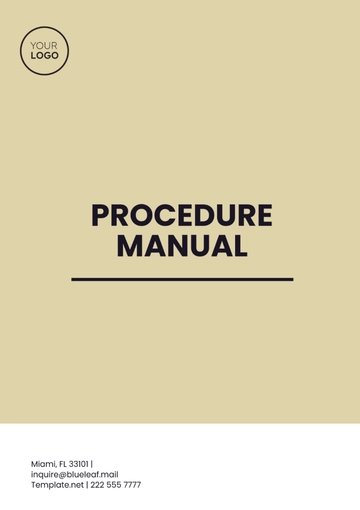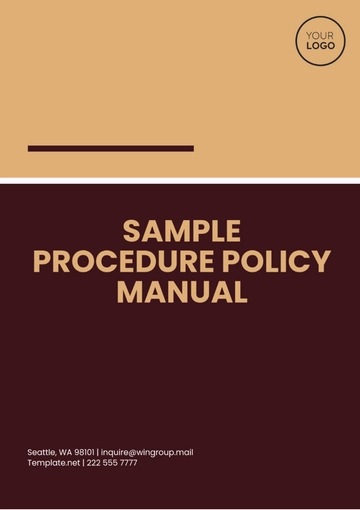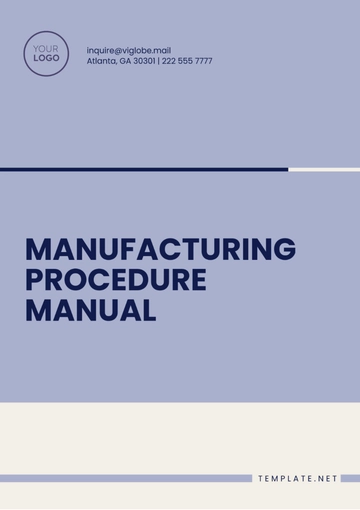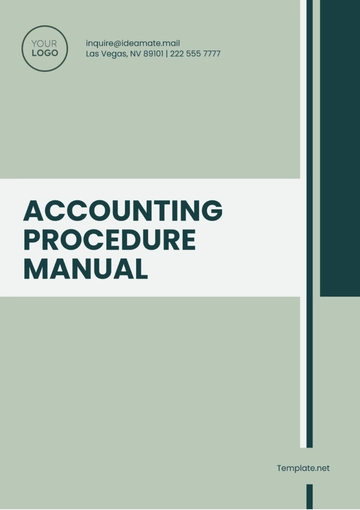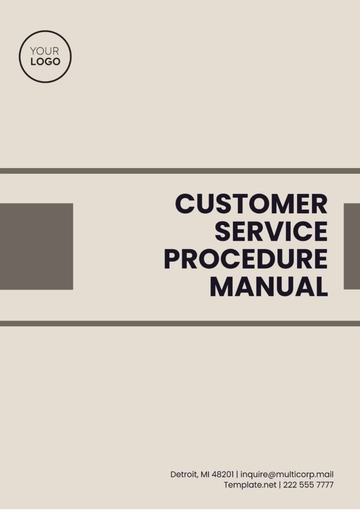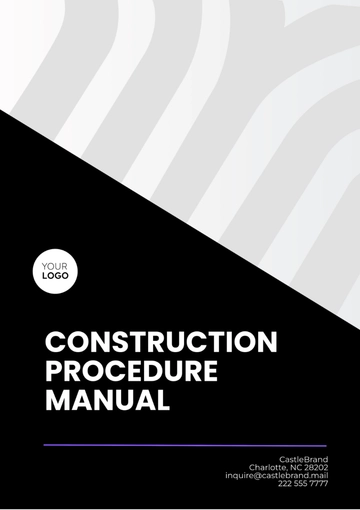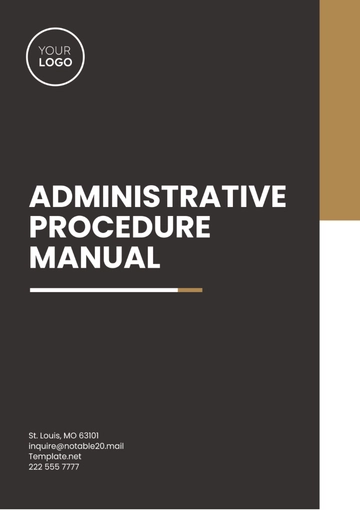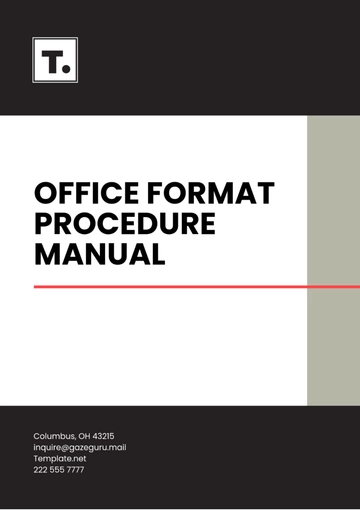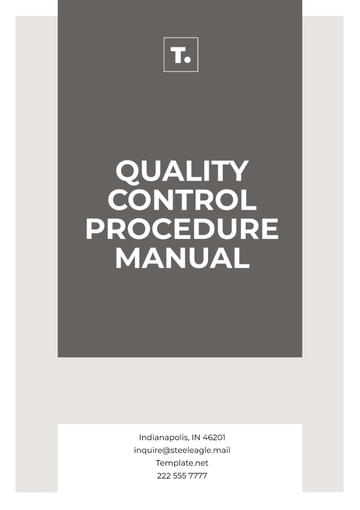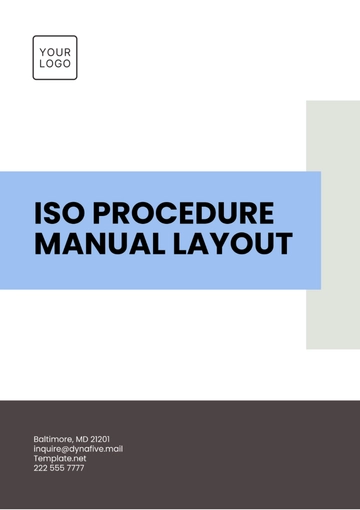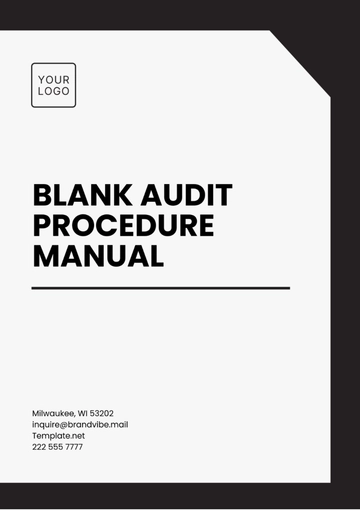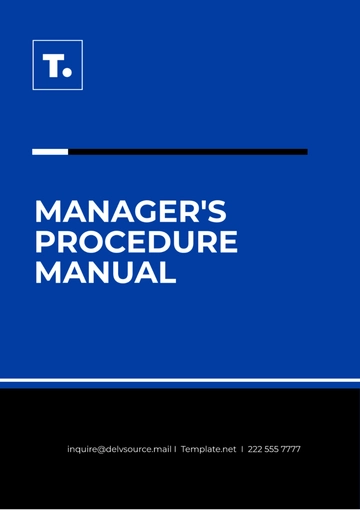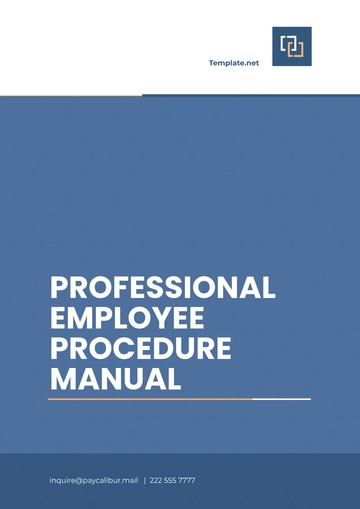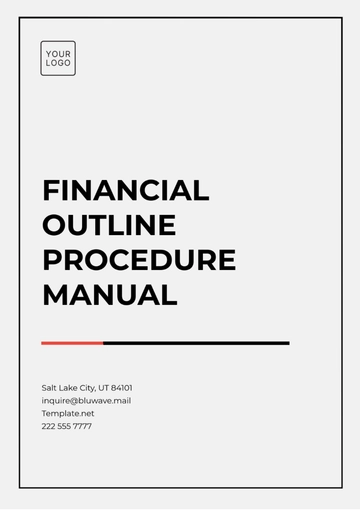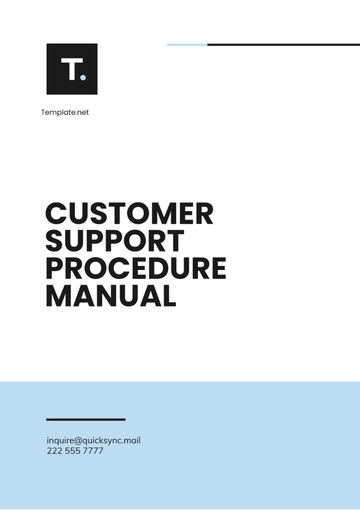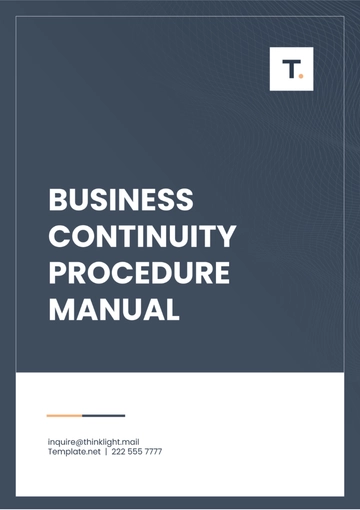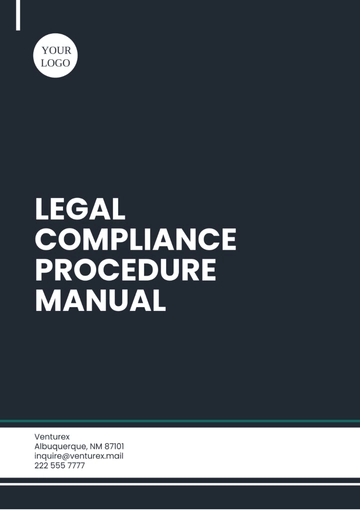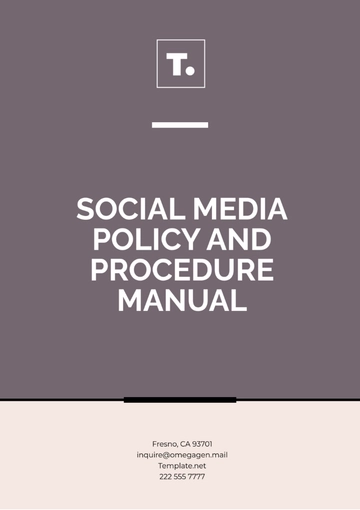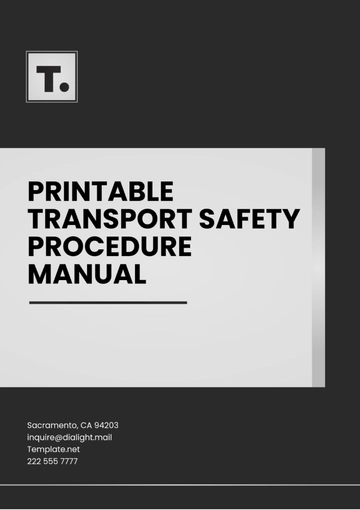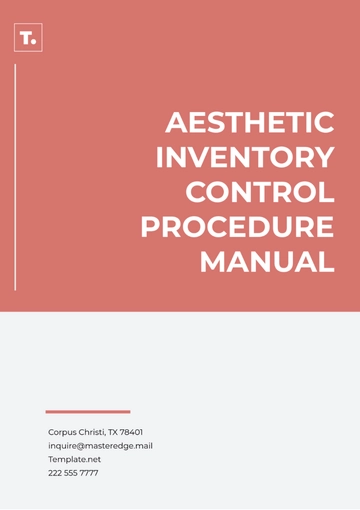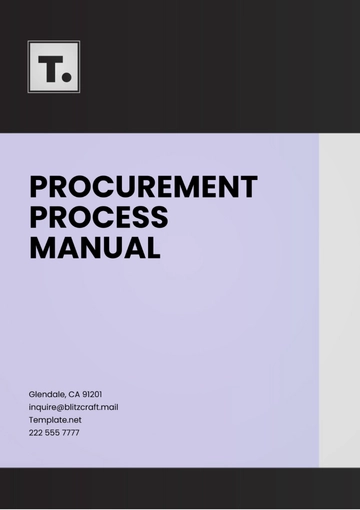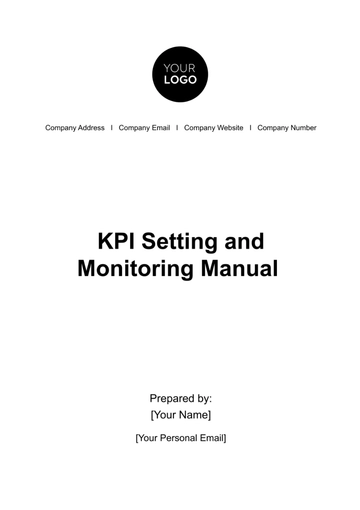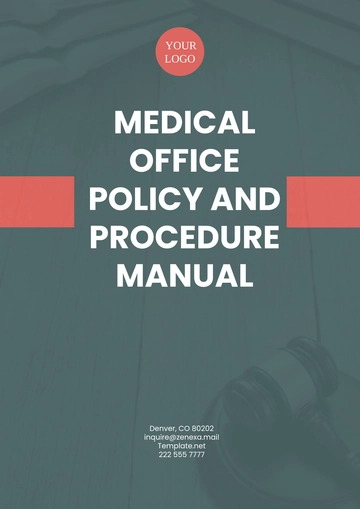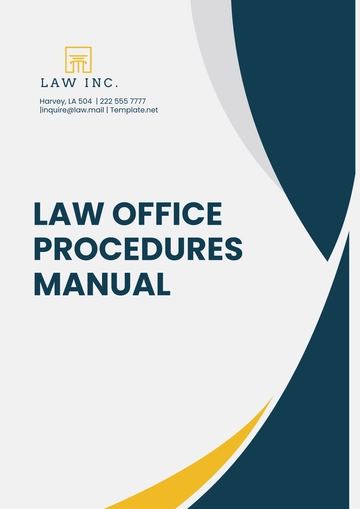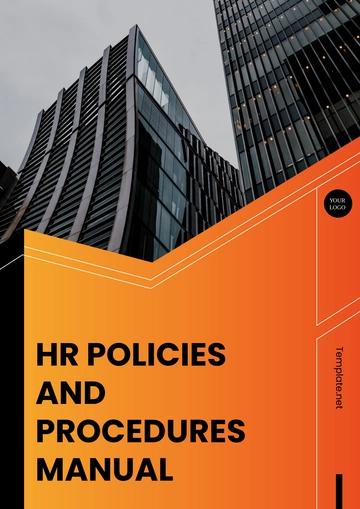Free Legal Corporate Compliance Procedures Manual
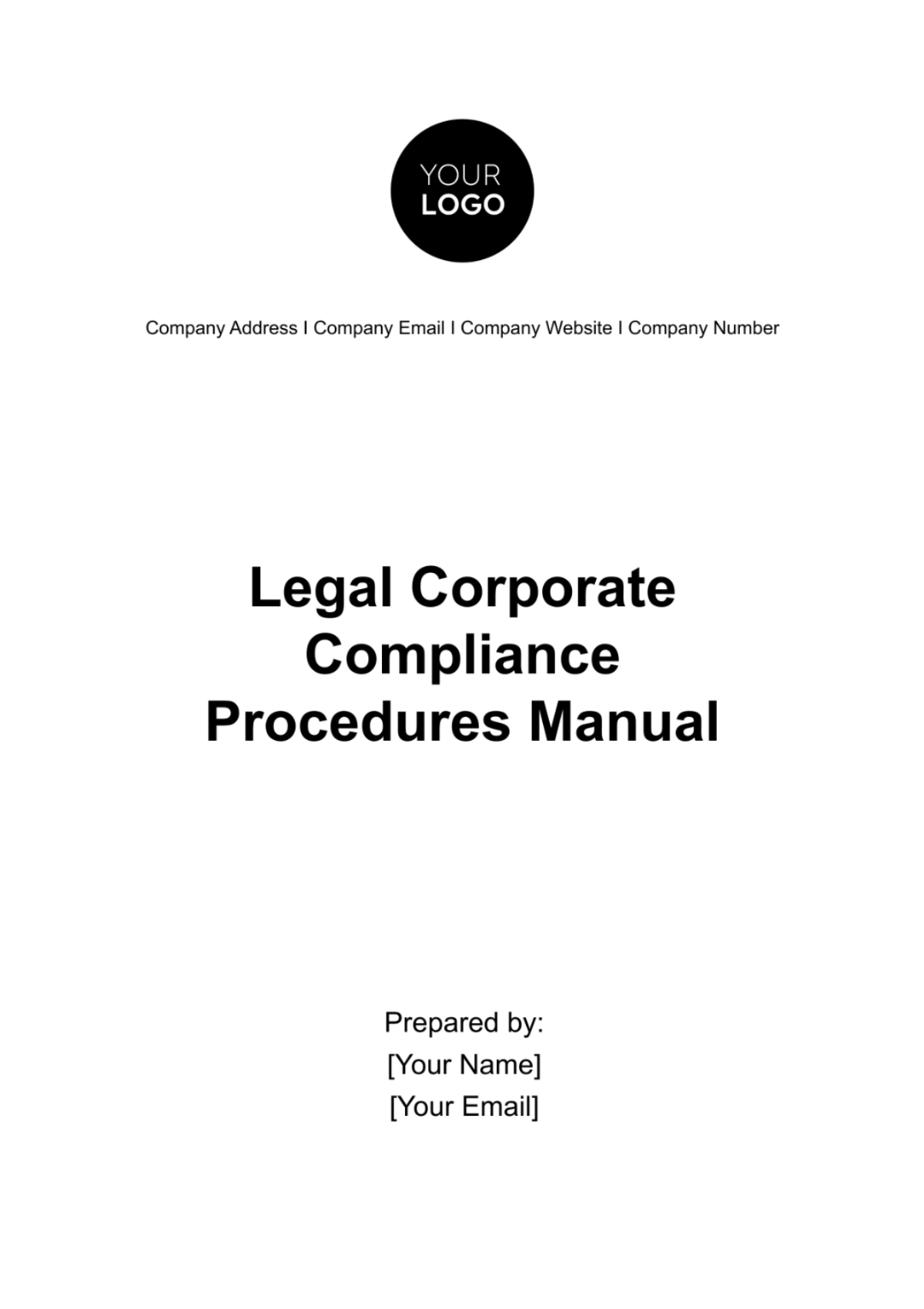
I. Introduction
The purpose of this Legal Corporate Compliance Procedures Manual is to provide our employees with a comprehensive guide to understanding and implementing the compliance policies and procedures that govern our operations. This manual is designed to ensure that all employees are fully informed about their role in maintaining legal and regulatory compliance across all aspects of our organization.
Compliance is integral to our organization's operations, underscoring our commitment to ethical business practices, legal integrity, and the highest standards of conduct. Adhering to compliance procedures not only helps us avoid legal liabilities and financial penalties but also enhances our reputation, fosters trust among our stakeholders, and contributes to a sustainable business environment.
II. Compliance Framework Overview
Our compliance program is structured to address the complex and diverse regulations that impact our business, ensuring that we meet all legal obligations and uphold our ethical standards. The program encompasses a wide range of areas, including but not limited to, financial reporting, anti-bribery and corruption, data protection, and employment laws. It is built on a foundation of policies, training, risk management, and monitoring systems designed to facilitate compliance and promote a culture of integrity and accountability.
Role | Responsibilities |
Compliance Officer | Oversees the compliance program, ensures policies are up-to-date, conducts risk assessments, and manages training programs. |
Compliance Committee | Supports the Compliance Officer in setting compliance priorities, reviews program effectiveness, and approves policies. |
Department Heads | Implement compliance policies within their departments, ensure staff compliance, and report to the Compliance Officer on compliance matters. |
All Employees | Adhere to compliance policies and procedures, participate in required training, and report any compliance concerns or violations. |
III. Detailed Compliance Procedures
Our compliance procedures are meticulously designed to ensure adherence to specific laws and regulations affecting our operations. These step-by-step procedures provide clear guidance to all employees, enabling them to understand and fulfill their compliance obligations effectively. By following these procedures, we mitigate the risk of legal violations and uphold our commitment to ethical business practices.
A. Compliance with Specific Laws and Regulations
Identify Applicable Regulations: Regularly review and identify laws and regulations relevant to our business operations. This includes staying informed about changes in legislation and regulatory guidance. Each department must work in conjunction with the Compliance Officer to understand the regulatory landscape of their specific operations. This foundational step ensures that all subsequent compliance efforts are accurately targeted and relevant.
Develop and Update Policies: Create and periodically update internal policies to reflect current legal and regulatory requirements. Policies serve as the backbone of our compliance program, providing a formalized structure for operations in accordance with legal standards. The Compliance Officer, with input from legal counsel and department heads, is responsible for ensuring policies are both comprehensive and current.
Communicate and Train: Disseminate policies to all employees and provide mandatory training to ensure understanding and competency in compliance matters. Effective communication and training are critical to ensuring that employees are aware of and understand compliance policies. Training programs are tailored to various roles within the organization and are updated regularly to reflect any changes in policies or regulations.
Monitor and Audit: Implement monitoring systems and conduct regular audits to ensure compliance with policies and regulations. Continuous monitoring and periodic audits help identify compliance gaps and areas for improvement. These activities are conducted by the Compliance Officer in collaboration with external auditors when necessary.
Report and Remediate: Establish mechanisms for reporting compliance issues and implement corrective actions to address any identified problems. An open environment where employees can report compliance concerns without fear of retaliation is essential. Upon receiving a report, the Compliance Officer coordinates an investigation and, if necessary, develops a remediation plan.
B. Documentation and Record-Keeping Requirements
Document Type | Retention Period | Description |
Compliance Training Records | 5 Years | Records of all compliance training sessions, including attendee lists and training materials. |
Audit Reports | 7 Years | Reports from internal and external audits, including findings and corrective actions taken. |
Policy Documents and Revisions | Permanently | All versions of compliance policies and procedures, including dates of revisions. |
Compliance Incident Reports | 7 Years | Documentation of compliance incidents, investigations, and remediation efforts. |
IV. Risk Management Procedures
Effective risk management is integral to our compliance program, enabling us to proactively identify, assess, and mitigate compliance risks. Our risk management procedures are designed to be dynamic, reflecting the evolving nature of our business and the regulatory environment.
A. Identifying, Assessing, and Mitigating Compliance Risks
Risk Identification: Continuously monitor our operations and the external regulatory environment to identify potential compliance risks. This involves gathering information from a variety of sources, including regulatory updates, industry news, and internal feedback, to pinpoint areas where compliance risks may arise.
Risk Assessment: Evaluate the identified risks in terms of their potential impact on our operations and the likelihood of their occurrence. Each identified risk is assessed to prioritize our compliance efforts. This assessment considers factors such as the severity of potential penalties, the risk's impact on our reputation, and its likelihood.
Risk Mitigation: Develop and implement strategies to mitigate identified risks, including revising policies, enhancing training, or adjusting operational practices. Based on the risk assessment, tailored mitigation strategies are deployed to address specific risks, with the goal of minimizing their potential impact and likelihood.
B. Conducting Risk Assessments
Engage Cross-Functional Teams: Involve representatives from various departments to ensure a comprehensive understanding of risks across the organization.
Use a Standardized Risk Matrix: Employ a risk matrix to consistently evaluate the impact and likelihood of identified risks.
Document and Review Assessments: Maintain detailed records of risk assessments and review them regularly to reflect changes in the business environment or regulatory landscape.
V. Policies and Standards
Our organization is committed to the highest standards of legal compliance and ethical conduct. To support this commitment, we have established a comprehensive set of policies and standards that govern our business operations and the behavior of our employees. These policies and standards are designed to guide employees in making decisions that align with our ethical principles and compliance obligations. It is imperative that all employees understand, embrace, and adhere to these guidelines as part of their daily responsibilities.
Act Ethically: Uphold the highest standards of ethical behavior in all business dealings and professional relationships.
Protect Confidential Information: Safeguard sensitive and confidential information, including proprietary, personal, and financial data.
Comply with Laws and Regulations: Adhere to all applicable laws, regulations, and industry standards relevant to our operations.
Report Compliance Violations: Promptly report any suspected violations of laws, regulations, or company policies through the designated reporting channels.
Avoid Conflicts of Interest: Identify and avoid situations that could lead to conflicts of interest or the appearance thereof.
Promote a Respectful Workplace: Foster an inclusive and respectful work environment, free from harassment, discrimination, and retaliation.
Maintain Accurate Records: Ensure that all business records are accurate, complete, and maintained in accordance with legal and regulatory requirements.
VI. Training and Education
To ensure that our employees are well-informed and equipped to adhere to our compliance standards, we have developed a comprehensive training and education program. This program covers essential compliance topics and is tailored to the specific needs of different employee groups within our organization. Regular participation in these training sessions is mandatory for all employees, reinforcing our culture of compliance and ethical conduct.
Program | Content | Frequency | Duration | Target Audience |
Compliance Orientation | Overview of compliance policies and standards | Upon hire | 2 hours | All new hires |
Anti-Bribery and Corruption | Laws, policies, and procedures to prevent bribery | Annually | 1 hour | Sales, Procurement, Executives |
Data Privacy and Security | Handling and protection of personal data | Annually | 1.5 hours | IT, HR, Customer Service |
Employment Law Compliance | Fair labor practices and workplace conduct | Annually | 1 hour | Managers, HR |
Conflict of Interest | Identification and management of conflicts | Bi-annually | 1 hour | All employees |
Recordkeeping Best Practices | Accurate and legal record maintenance | Annually | 1 hour | Finance, Administration |
VII. Reporting Violations
Our organization has established a clear and accessible process for reporting suspected violations of laws, regulations, or company policies. We encourage all employees to report any concerns or violations they observe, as this is crucial for maintaining our integrity and compliance. We are committed to ensuring that all reports are treated seriously, confidentially, and professionally.
A. Procedures for Reporting Suspected Violations
Identify the Concern: Be clear about the issue you are reporting, including any relevant details, dates, and individuals involved.
Use Established Channels: Report the concern through one of the established channels, such as the compliance hotline, email, or direct communication with the Compliance Officer.
Provide Detailed Information: Include as much detail and documentation as possible to facilitate the investigation of the report.
Cooperate with Investigations: If asked, provide further information or assistance to those conducting the investigation.
B. Anonymity and Protection from Retaliation for Whistleblowers
We guarantee anonymity for employees who wish to remain anonymous when reporting violations. Additionally, our organization strictly prohibits any form of retaliation against employees who report suspected violations in good faith. We have put measures in place to protect whistleblowers from retaliation, discrimination, or adverse employment consequences. Any incidents of retaliation will be investigated and addressed promptly, including disciplinary action against those found responsible for retaliatory behavior.
VIII. Investigation of Violations
Upon receiving a report of a suspected violation, our organization follows a structured process to investigate the matter thoroughly and impartially. Our goal is to resolve all reports of non-compliance in a manner that upholds our commitment to integrity and compliance.
A. Investigating Reported Compliance Violations
Preliminary Assessment: Quickly assess the report to determine the need for a full investigation.
Assemble Investigation Team: Form a team of individuals with the appropriate expertise, including members from the compliance, legal, and HR departments, as necessary.
Gather Information: Collect all relevant documents, emails, and other evidence related to the reported violation.
Conduct Interviews: Interview the reporting individual, witnesses, and anyone else who may have relevant information.
Analyze Findings: Review all collected information to determine whether a violation occurred.
Conclude the Investigation: Make a determination based on the evidence and document the findings.
B. Documentation and Resolution of Investigations
All steps of the investigation process, from the initial report to the final resolution, are documented meticulously. This documentation includes records of interviews, collected evidence, analysis of findings, and any disciplinary actions taken. The resolution of the investigation may involve corrective actions to address the violation and prevent its recurrence, such as policy revisions, additional training, or disciplinary measures. Our approach ensures transparency, accountability, and the continuous improvement of our compliance program.
IX. Disciplinary Actions
Our organization takes compliance violations seriously and has established clear guidelines for disciplinary measures to address such incidents. These measures are essential for maintaining accountability, reinforcing our commitment to compliance, and deterring future violations.
A. Guidelines for Disciplinary Measures
We apply disciplinary actions in a fair, consistent, and proportionate manner, taking into account the severity and frequency of the violation, as well as the individual's past conduct and cooperation during the investigation. Disciplinary measures may include verbal warnings, written warnings, suspension, demotion, termination, or other appropriate actions.
B. Procedures for Implementing Disciplinary Actions
Investigation Confirmation: Ensure that the investigation confirms the existence of a violation and identifies the responsible party.
Determine Appropriate Action: Evaluate the severity of the violation and determine the appropriate disciplinary action based on established guidelines.
Notify the Employee: Inform the employee of the disciplinary action being taken, providing clear reasons and expectations for improvement.
Document the Action: Document all disciplinary actions taken, including the reasons, date, and outcome, and maintain this documentation in the employee's personnel file.
Follow-Up and Monitoring: Monitor the employee's compliance and conduct follow-up actions as necessary to ensure adherence to company policies and standards.
X. Third-Party Compliance
Ensuring compliance extends beyond our organization to include our vendors, contractors, and partners. We recognize the importance of holding third parties to the same standards of conduct and integrity that we uphold internally. To achieve this, we have implemented robust procedures for managing third-party compliance.
A. Procedures for Ensuring Third-Party Compliance
Vendor Selection Process: Prioritize compliance considerations in the vendor selection process, assessing vendors' commitment to compliance and integrity.
Contractual Obligations: Include compliance requirements in contracts and agreements with third parties, outlining expectations, responsibilities, and consequences for non-compliance.
Due Diligence: Conduct due diligence assessments to evaluate the compliance posture of potential vendors or partners, including background checks, financial screenings, and reputational assessments.
Monitoring and Oversight: Regularly monitor third-party activities to ensure ongoing compliance with contractual obligations and regulatory requirements.
Reporting Mechanisms: Establish mechanisms for reporting potential compliance issues related to third-party relationships and encourage open communication channels.
Training and Awareness: Provide training and guidance to third parties on our compliance expectations and the importance of adhering to ethical and legal standards.
B. Due Diligence and Monitoring of Third-Party Relationships
We understand that maintaining compliance requires ongoing diligence and monitoring of third-party relationships. Our organization continuously evaluates the effectiveness of our third-party compliance program and makes improvements as needed to mitigate risks and uphold our commitment to integrity.
XI. Monitoring and Auditing
Our organization conducts regular monitoring and auditing activities to ensure the effectiveness of our compliance controls and procedures. These activities occur on a scheduled basis, with quarterly internal audits conducted by our dedicated compliance team. Additionally, we engage external auditors annually to perform independent reviews of our compliance processes and practices. Through these systematic reviews and evaluations, we assess our adherence to regulatory requirements and internal policies, identify any potential gaps or deficiencies, and take proactive measures to address them promptly.
XII. Continuous Improvement
Continuous improvement is ingrained in our compliance culture, guiding us to refine and optimize our practices over time. To incorporate feedback for continuous improvement, we utilize a multifaceted approach. Firstly, we actively seek input from employees, stakeholders, and external parties through surveys, focus groups, and feedback mechanisms embedded in our compliance communication channels. Secondly, we analyze audit findings, incident reports, and compliance metrics to identify trends and areas for enhancement. Thirdly, we convene regular meetings of our compliance steering committee to review performance metrics, discuss emerging risks, and prioritize improvement initiatives. Finally, we allocate resources and assign responsibilities for implementing corrective actions and process enhancements, ensuring accountability and follow-through on our commitment to excellence in compliance governance and performance.
- 100% Customizable, free editor
- Access 1 Million+ Templates, photo’s & graphics
- Download or share as a template
- Click and replace photos, graphics, text, backgrounds
- Resize, crop, AI write & more
- Access advanced editor
Introducing the Legal Corporate Compliance Procedures Manual Template from Template.net, your essential tool for establishing clear compliance protocols within your corporation. This editable and customizable template is meticulously designed to help you document all necessary compliance procedures. Editable in our AI Editor tool, it simplifies the process of creating a detailed manual that fosters a compliant and ethical business environment.
